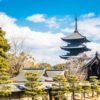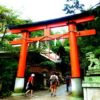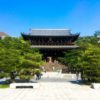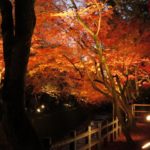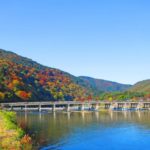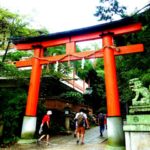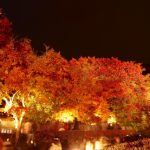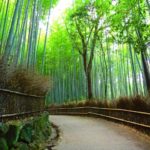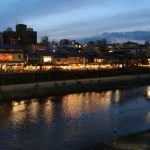9月 30, 2017
The 10 Best Places to See Cherry Blossom in Kyoto, Japan
- 1,943view
Kyoto is an old capital of Japan with four distinctive seasons. Autumn with red leaves, winter covered with snow and green summer are all beautiful but spring with cherry blossoms is definitely the best. Kyoto has cherry blossoms everywhere and some famous touristic attractions such as Kinkakuji or Kiyomizudera also are also known for cherry blossoms. Here we listed a bit less known spots for cherry blossoms in Kyoto.
1. Former Kyoto Prefectural Office Main Building
photo by satoshi5089 / embedded from Instagram
Former Kyoto Prefectural Office Main Building is a classical building in a renaissance-style built in 1904. Now it is registered as a national Important Cultural Property.
Once used as an office building for Kyoto Prefecture, it’s a touristic attraction currently as one of the oldest chamber hall. There are seven cherry trees in the courtyard including a weeping cherry tree which is the same family as the one in Maruyama Park.
One of them is a rare bleed and named “Katamorizakura” by Mr. Sano Toemon, a famous gardener in 2010. This is a great spot you can enjoy both beautiful garden and the heritage building.
Name: Former Kyoto Prefectural Office Main Building
Address: Yabunouchi-cho, Kamigyō-ku, Kyōto-shi
Tel: +81-75-411-5000
Open: 8:30-17:15
Closed: None
Access: 10min walk from Marutamachi Station
Website: http://www.pref.kyoto.jp/
Map: Map to Former Kyoto Prefectural Office Main Building
2. Uhouin
photo by helvetica / embedded from Instagram
This temple is less known but it’s a great spot for cherry blossoms. It’s also known with the name “Nishijin Seitengu. There are various types of cherry trees in the garden. Outstanding one is “Gyoikou Sakura” which has light-green pedals. This green flowers stand out among other light pink cherry blossoms.
Falling pedals in the garden are so beautiful. There is no entrance free. How about visiting this temple?
Name: Uhouin
Address: 9-3 Shōtenchō, Kamigyō-ku, Kyōto-shi
Tel: +81-75-441-8678
Open: 9:00-17:00
Closed: None
Access: 5min walk from Imadegawa Jofukuji Bus Stop
Map: Map to Uhouin
3. Nijo Castle
photo by yxvxh / embedded from Instagram
Nijo castle was built during the Edo period and has been used as a royal detached palace recently. Now Ninomaru gotten (one of the buildings in the castle) is registered as a National Heritage.
Other 22 buildings are also listed as national Important Cultural Properties. In 1994, it was also registered in UNESCO World Heritage. There are 400 cherry trees in the castle.
In the cherry season, trees are illuminated at night and the view at night is stunning. In this season, the castle is open for longer hours until 21:30.
Name: Motorikyu Nijo Castle
Address: 541 Nijōjōchō, Nakagyō-ku, Kyōto-shi
Tel: +81-75-841-0096
Open: 8:45-17:00
Closed: None
Access: 5min walk from Metro Nijojomae Station
Website: http://www2.city.kyoto.lg.jp/
Map: Map to Motorikyu Nijo Castle
4. Yoshimine dera
photo by katsu_e46 / embedded from Instagram
Youshimine dera is known for its beautiful 300 years old weeping cherry tree. It is said to be planted by Keishoin who was a concubine of the third Edo shogun Tokugawa Iemitsu and mother of the fifth shogun Tsunayoshi.
It’s triangled with an old maple tree. This tree became famous as it was featured in JR Tokai’s TV advertisement “Let’s go to Kyoto”.
There are many other types of cherry trees in the garden. 100 cherry trees all bloom slightly different timings in April and you can enjoy flowers at any time in April.
Name: Yoshiminedera
Address: 1372 Ōharano Oshiochō, Nishikyō-ku, Kyōto-shi
Tel: +81-75-331-0020
Open: 8:00-17:00
Closed: None
Access: 40min by Hankyu Bus from Mukomachi Station
Website: http://www.yoshiminedera.com/
Map: Map to Yoshiminedera
5. Ninnaji
photo by yatzu817 / embedded from Instagram
Ninnnaji, the head temple of the Omuro group of the Shingon Sect and was founded in 888 by Emperor Uda. It’s also called “Omuro Imperial Palace” Emperor Uda built “Omuro” building in Ninanaji and moved in after retiring from his throne and becoming a monk. The temple is famous for cherry blossoms.
Many people visit the temple for seeing cherry blossoms in sprint time but one of the most admired cherry trees in the temple is “Omuro Sakura” located on the western side of the temple, which blooms rather later than other trees. The beauty of “Omuro Sakura” has been admired in many poems.
Admission is usually free but there are some fee is charged only during the cherry blossom season when there is a cherry festival event is held. Do you want to take a photo with cherry flowers here?
Name: Ninnaji
Address: 33 Omuroōuchi, Ukyō-ku, Kyōto-shi
Tel: +81-75-461-1155
Open: 9:00-17:00
Closed: None
Access: 10 min by City Bus 26 from Enmachi Station
Website: http://www.ninnaji.or.jp/
Map: Map to Ninnaji
You May Also Like:
→The 10 Best Spots to See Autumn Leaves in Kyoto, Japan
6. Maruyama Park
photo by zhishanpu / embedded from Instagram
Maruyama Park is known for as a scenic beauty spot. This is one of the oldest parks in Kyoto City and used to be a part of the temple and the shrine. After damaged by the fire, it was rebuilt as a Japanese garden in 1912. There are about 680 various types of cherry trees in the park. Tourists enjoy flowers in the park in spring.
The most famous cherry tree is “Gion Yozakura” which is located in the center of the park and said to be loved by Akiko Yosano, a famous female author. The original tree died but the tree grown from the seed of the original is blooming now.
Name: Maruyama Park
Address: Maruyama cho, Higashiyama Ward, Kyoto
Tel: +81-75-561-1350
Closed: None
Access: 20min by City Bus 206 from Kyoto Station, 3 min walk from Gion Bus Stop
Website: http://www.city.kyoto.lg.jp/
Map: Map to Maruyama Park
7. Heian Jingu
photo by takako_nkns / embedded from Instagram
Heian Jingu was built in 1895, the 1100th anniversary after the capital moved to Kyoto. It replicated the royal palace when the capital was moved. It was burnt a couple of times but six buildings in Heian Jingu are now registered as national Important Cultural Propertie.
300 cherry trees bloom in Heianjingu in spring time. “Sakon no Sakura” (Cherry on left) with white pedals in front of Taikyokuden is especially famous. It’s a pair with “Ukon no Tachibana” (Citrus on right). “Satogaeri no sakura” a red weeping cherry tree is also well-known. It’s worth visiting here.
Name: Heian Jingu
Address: Okazaki Nishitennocho, Sakyo Ward, Kyoto
Tel: +81-75-761-0221
Open: 8:30-18:00
Closed: None
Access: 10min walk from Higashiyama Station
Website: http://www.heianjingu.or.jp/
Map: Map to Heian Jingu
8. The Kamo River Nakaragi no michi
photo by miyi8889 / embedded from Instagram
Nakaragi no michi is an 800 meter long passage along the Kamo River on the western side of Kyoto Prefecture Botanic Garden. It is known for the tunnel of beautiful red weeping cherry trees.
The Kamo River merges with the Takano River flowing on the east at the downstream. Besides Nakaragi no michi, there are many cherry trees planted along the Takano River and the Kamo River. Enjoy walking along the rivers in spring time.
Name: The Kamo River Nakaragi no michi
Address: Shimogamo Hangicho, Sakyo Ward, Kyoto
Tel: +81-75-222-4130
Open: 24h
Closed: None
Access: 8min walk from Kitayama Station
Map: Map to The Kamo River Nakaragi no michi
9. Byodoin
photo by manumarfer / embedded from Instagram
Byodoin was built in 998 and registered as a world heritage. In spring time, you can also enjoy beautiful cherry blossoms in the garden. Beautiful Somei Yoshino and weeping cherry trees are reflected on the water surface of the pond in front of the main building.
The Uji River running near Byodoin is also famous for cherry trees. It’s recommended to visit both Byodoin and the Uji River. It is a breathtaking experience to admire beautiful cherry blossoms in this traditional heritage Byodoin.
→The 10 Best Places to Eat in Uji, Kyoto, Japan
Name: Byodoin
Address: Renge-116 Uji, Uji-shi, Kyoto
Tel: +81-774-21-2861
Closed: None
Access: 10min walk from Uji Station
Website: http://www.byodoin.or.jp/
Map: Map to Byodoin
10. Yamashina sosui no sakura
photo by leather315 / embedded from Instagram
Yamashina Sosui (Canal) carries water from Lake Biwa. Both banks are decorated by cherry blossoms in spring time. 660 cherry trees are planted along the canal and the banks are known as a nice walking pass. Vivid yellow colors of field mustard flowers along the canal also add cheerfulness to the spring view.
When you walk towards north from Anshu Bridge, you find “Bishamondo” which is known for Bishamon weeping cherries. Enjoy walking along this nice pass with cherry blossoms. You would love the landscape.
Name: Yamashina Sosui no sakura
Address: Shinomiyashinkaibata, Yamashina Ward, Kyoto
Tel: +81-75-643-5405
Closed: None
Access: 10min walk from Yamashina Station
Map: Map to Yamashina Sosui no sakura
Enjoy cherry blossoms in Kyoto!
Are you interested in these spots? Kyoto is a popular destination for both Japanese and overseas visitors. Beautiful landscape, delicate cuisine, traditional shrines and Buddhist temples. All of them are wonderful and recommended. If you are coming to Japan, do not miss Kyoto! Especially in spring, head to Kyoto for cherry blossoms.





